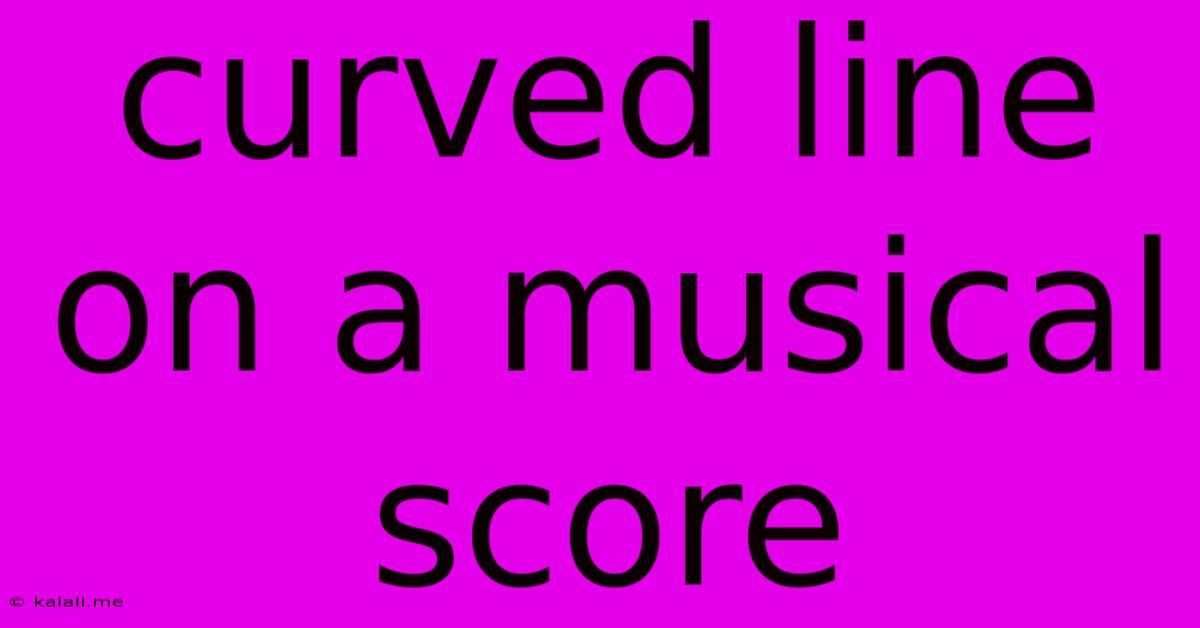Curved Line On A Musical Score
Kalali
May 21, 2025 · 3 min read

Table of Contents
Decoding the Curves: Understanding Curved Lines in Musical Notation
Curved lines in musical notation, often overlooked, are crucial for understanding phrasing, articulation, and dynamics. They provide a visual representation of the composer's intended interpretation, guiding performers toward a more expressive and nuanced performance. This article will delve into the various types of curved lines used in musical scores and their significance. Understanding these subtle cues will significantly enhance your musical reading and performance skills.
Types of Curved Lines and Their Meanings
Several types of curved lines appear in musical scores, each conveying a different musical instruction:
-
Slurs (Legato): These are arguably the most common curved lines. They connect notes played smoothly and connectedly, without any break or separation between notes. The slur emphasizes a legato articulation, ensuring a flowing, uninterrupted sound. Think of it as a single, unbroken musical phrase. Slurs are essential for phrasing and creating musical unity within a passage.
-
Phrasing Slurs: While similar to legato slurs, phrasing slurs often encompass a larger musical phrase, sometimes spanning multiple measures. They guide the performer in shaping the musical line and understanding the overall structure of the piece. These broader slurs often highlight sections that share a common melodic or harmonic character.
-
Accent Slurs: These are less common but equally important. They usually connect two notes where the first note is accented and the second is played softer. This creates a dynamic contrast within a small musical phrase. They help avoid a monotonous or jarring transition between notes. Accents within a slur create subtle nuances that are crucial for expressive performance.
-
Tie: Although visually similar to a slur, a tie connects two notes of the same pitch. Unlike a slur, the tied notes are played as a single, sustained note. The tie indicates the duration of the note across multiple beats or measures. The tie is primarily used to extend the duration of a note, not to imply a legato articulation.
Interpreting Curved Lines for Performance
The effective use of curved lines in performance requires careful attention to detail. Here are some considerations:
-
Context is Key: The interpretation of curved lines should always consider the overall context of the piece. The composer's style, the surrounding dynamics, and the overall tempo will all influence how the curved lines should be interpreted.
-
Balance and Shaping: Curved lines often dictate the balance and shaping of the musical phrase. Performers must pay attention to the subtle nuances within the curve to create a natural and expressive musical arc.
-
Dynamics and Articulation: Curved lines can work in conjunction with dynamic markings and articulation symbols to shape the musical expression. The dynamic markings and articulation marks often define the character of individual notes while the curved line guides the overall phrasing.
-
Practice and Refinement: Mastering the interpretation of curved lines requires extensive practice and refinement. Performers should experiment with different approaches to phrasing to find the most effective way to express the composer's intent.
Beyond the Basics: Advanced Considerations
While the above covers common types of curved lines, some scores may utilize less common variations or markings. Always consult resources specific to the musical style and composer for clarification.
Understanding and interpreting the various curved lines in a musical score is a key aspect of musicianship. By carefully analyzing these visual cues, performers can achieve a more expressive and nuanced performance, bringing the composer's vision to life. The ability to interpret these subtle details will elevate your performance to a new level of sophistication.
Latest Posts
Latest Posts
-
Burning The Candle At Both Ends Origin
May 22, 2025
-
Vlc Player How To Rotate Video
May 22, 2025
-
How To Say My Name Is In Japanese
May 22, 2025
-
How Long After Tiling Can You Grout
May 22, 2025
-
How Long Does Spag Bol Last In Fridge
May 22, 2025
Related Post
Thank you for visiting our website which covers about Curved Line On A Musical Score . We hope the information provided has been useful to you. Feel free to contact us if you have any questions or need further assistance. See you next time and don't miss to bookmark.